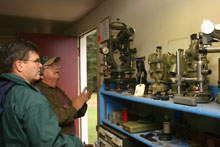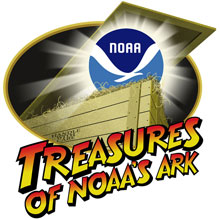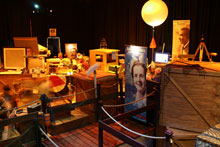Preserving NOAA and the Nation's Heritage
NOAA has in its care a wealth of heritage resources that recall the agency’s proud history and legacy of science, service, and stewardship to the nation. NOAA is working to preserve, protect, and promote our heritage resources—from historic maps and charts to buildings and shipwrecks—and make these resources accessible to the public through innovative programs and partnerships.
- Introduction
- Conserving Our Heritage
- Treasures of NOAA's Ark
- The Preserve America Initiative
- Conclusion

The Treasure of NOAA’s Ark exhibit showcases an array of resources which help to tell the reach history of the people and ideas that have shaped NOAA and its predecessor agencies for two centuries.
The history of NOAA and the nation are intertwined. It is difficult to talk about weather, water, climate, and commerce without discussing NOAA and its ancestor agencies: the U.S. Coast Survey, the U.S. Weather Bureau, and the U.S. Commission of Fish and Fisheries.
Today, NOAA has in its care a wealth of resources that recall the agency’s proud history and dedicated service to the nation. Such resources include maps, nautical charts, photographs, books, scientific instruments, and other artifacts – some of which are centuries old. NOAA is also the steward of large-scale historic and cultural resources, including buildings and even shipwrecks.
“NOAA has an astounding array of historic items that tell the NOAA story, which is one of innovation, leadership, and service to the nation,” said Daniel J. Basta, director of the NOAA National Marine Sanctuary Program, which protects the wreck of the famed Civil War ironclad USS Monitor and other historic assets. “We recognize that it’s up to each of us to be good stewards of these resources, which really belong to the American people.”
NOAA Employees: Conserving Our Heritage
Employees throughout the agency have stepped up their efforts to ensure that NOAA’s heritage assets are inventoried, protected, and conserved so the objects will endure for generations to come. For many, it is a labor of love. Just ask Kendall Fancher, the chief of the NOAA National Geodetic Survey (NGS) Instrumentation and Methodologies Branch in Corbin, Virginia. Kendall’s group has been dusting off, cataloguing, and cleaning up a variety of instruments that were retired long ago, including a 1930s cosmic ray meter, a portable World War II-era tide computer, and a 19th century ceramic survey marker.

NOAA employees Albert "Skip" Theberge and David Doyle examine a number of long-retired instruments at the NOAA National Geodetic Survey facility in Corbin, Virginia. Click image for larger view.
“The classic survey instruments located at the Corbin facility are tangible links with the history of the National Geodetic Survey,” says Fancher. “I feel these artifacts should be preserved and made available for others so they might reflect on the great advances in technology and the many accomplishments made by NGS during that last two centuries.”
Many of these instruments were cutting-edge technology upon their introduction, as were so many other instruments now in NOAA’s care.
“Seeing all the beautifully crafted old instruments really makes you think about all the people who have contributed to making NOAA what it is today—the scientists, the inventors, the people who created and used this marvelous equipment,” says Lynette Joynes of the NOAA Property Office.
Sharing the Legacy: Treasures of NOAA’s Ark
But NOAA is doing more than just counting and conserving its heritage resources. The agency is making sure that the public has an opportunity to see and learn about the resources first hand.

NOAA has a wealth of heritage resources that recall the agency's proud history and legacy of service to the nation. Treasures of NOAA’s Ark, a selective exhibit of NOAA heritage items, is one way that NOAA shares its history with the public. Click image for larger view.
In 2005, NOAA created “Treasures of NOAA’s Ark,” a temporary, museum-quality exhibition of selected NOAA heritage items representing the history of NOAA and its ancestor agencies. Located at NOAA headquarters in Silver Spring, Maryland, the exhibit enabled NOAA employees, the general public, and students to view the “best of the best” of NOAA’s heritage resources and to learn about the people and technology that have helped make NOAA what it is today.
Feedback about this first Treasures of NOAA’s Ark exhibit was so positive that the exhibit has become a regular part of NOAA Heritage Week, a first-of-its-kind annual celebration that takes place each February.
In 2006, the theme for the Treasures of NOAA’s Ark was “Pioneers: People and Technology.” The exhibit highlighted groundbreaking technologies developed by NOAA and its predecessors that have helped save lives, promote commerce, and expand our knowledge of the Earth. The exhibit also celebrated eight pioneering individuals affiliated with NOAA and its ancestor agencies who have made significant contributions to our understanding of land, sea, and sky.

NOAA Heritage Week 2006 highlighted the people and technology that have served NOAA and the nation since 1807. Click image for larger view.
The 2007 edition of Treasures of NOAA’s Ark, which will focus on the 200th Anniversary of the U.S. Coast and Geodetic Survey, will open in Silver Spring, Maryland, and run from February 5-14. Admission is free.
Recognizing that NOAA’s heritage is also the nation’s heritage, in 2006, NOAA created a traveling version of Treasures of NOAA’s Ark in partnership with Nauticus–The National Maritime Center in Norfolk, Virginia. It is estimated that over 100,000 people experienced the Treasures exhibit at Nauticus during its six-month run.
In 2007, the exhibit will travel to the Pacific Science Center in Seattle, Washington, opening in March.
“We are excited to partner with public institutions to tell the NOAA story and how NOAA missions impact the everyday lives of citizens,” said Cheryl Oliver, NOAA Preserve America Initiative senior program advisor.
The Preserve America Initiative
NOAA’s efforts to preserve, protect, and promote its historic resources and heritage has caught the attention of the Advisory Council on Historic Preservation (ACHP), the federal agency lead for the White House’s Preserve America Initiative. This initiative challenges federal agencies to increase efforts to inventory, preserve, and showcase federally managed historic resources and to foster tourism in partnership with local communities in the private sector. In 2004, NOAA received ACHP’s first-ever award for excellence in federal preservation.

To further support the Preserve America Initiative, NOAA has since established its own heritage preservation program, the NOAA Preserve America Initiative. As part of that effort, NOAA is working to foster partnerships between NOAA, non-governmental organizations, and communities across America in which NOAA has a presence. Through these partnerships, NOAA works to preserve, protect, and promote our common historic resources and heritage, whether it is the wreck of the Monitor, now protected as a NOAA National Marine Sanctuary, or historic Fort Crockett in Galveston, Texas, which houses a NOAA National Marine Fisheries Service laboratory and the headquarters of the NOAA Flower Garden Banks National Marine Sanctuary.

Once an army post, historic Fort Crokett in Galveston, Texas, a Preserve America Community, is now home to several NOAA offices. Click image for larger view.
“My hat is off to NOAA not only for preserving the story of the agency and those who came before, but for working with their neighbors in the communities in which NOAA facilities exist and helping those towns and cities tell their story in conjunction with the story that NOAA is preserving and telling,” said ACHP Chairman John L. Nau, III. “That’s really the objective of Preserve America.”
Conclusion
The history of NOAA and the nation are intertwined. For 200 years, NOAA and its ancestor agencies have played an integral role in understanding and managing our weather, water, climate, and commerce. By sharing maps, charts, photographs, books, scientific instruments, and other artifacts with NOAA employees and the general public, NOAA is working to preserve the resources that reflect the agency's proud history and dedicated service to the nation.
Contributed by David Hall, NOAA’s National Ocean Service
